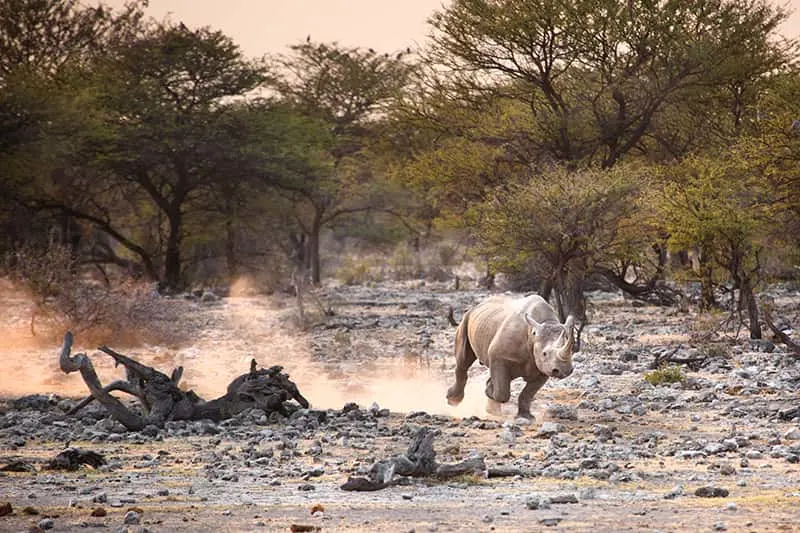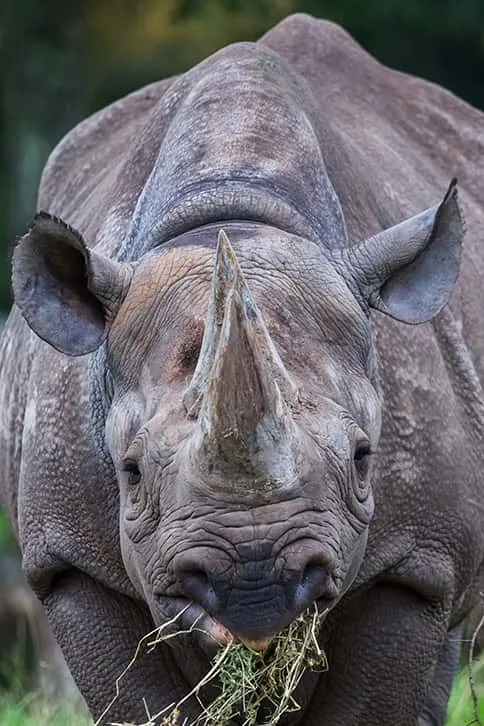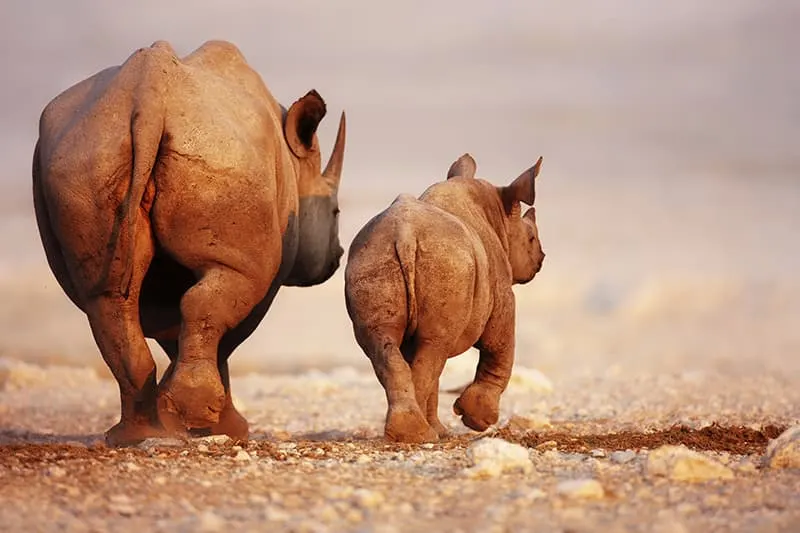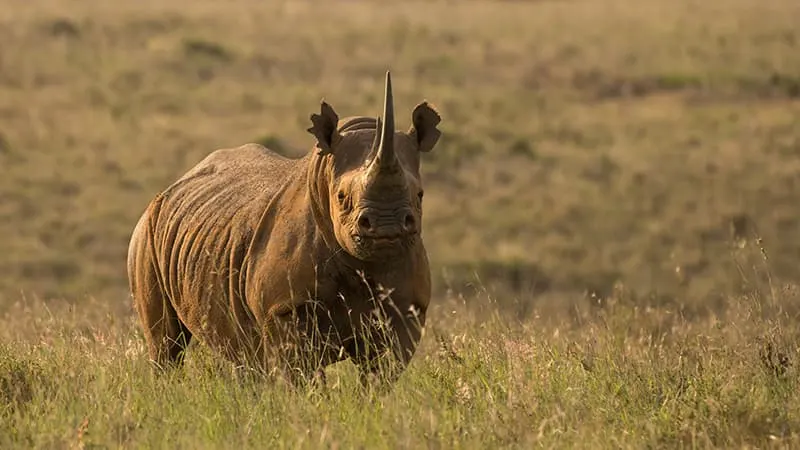Want to learn some black rhino facts for kids? You’ll find them in this post. We’ll talk about their physical description, diet, offspring, and more!

The black rhinoceros is one of two African species of rhinoceros.
Physical Description
Black rhinoceros have a large head with a short neck, a stocky body, and short legs. They have four hooved feet with three toes. They have thin tails that hang about halfway down their bodies. Black rhinos have small black eyes set in facial wrinkles. They have two horns on their snouts. The front horn is larger, and the rear horn is smaller. Black rhinos are dark grey. Black rhinos can appear to be other colors, like brown or white. They roll in mud in their habitat, and the dried mud affects their color.
Black rhinoceros are large creatures. They are half the height of a Jeep and can weigh as much as a pickup truck. A black rhinoceros grows to be fifteen hundred to twenty-nine hundred pounds. They stand five to six feet tall. Female rhinoceros are smaller than males.
Habitat
Black Rhinos live in different areas of the African continent. Almost all of the black rhino population is found in the countries of South Africa, Namibia, Zimbabwe, and Kenya. The black rhinoceros can live in a variety of habitats that range from open plains to dry forests. They mostly live in grasslands, savannahs, and tropical bush habitats.

Habits
Black rhinos are typically solitary creatures and territorial. Male rhinos have a smaller territory than females. A male rhino's territory is about two-and-a-half miles. A female rhino's territory is double that size. Both male and female rhinos mark their territory with urine and poop.
Black rhinos can be active both day and night. They are the least active during the hottest part of the day. Black rhinoceros are most active and look for food during the night, and at dusk and dawn.
Birds called ox-peckers spend a lot of time hitchhiking on the backs of black rhinos. The birds and the oxpeckers help each other. The birds remove ticks and other insects from the black rhino’s skin. They also eat parasites from their host's wounds. Ox-peckers receive their nutrients from feeding on the rhino's skin. The skin of the black rhino is kept free from biting insects and infections. When two creatures help each other, it’s called a “symbiotic relationship”.
Horns
Black rhino horns are not bone. The horns of a rhino are made of keratin. Keratin is the same thing that human hair and nails are made of. The horn grows just as our nails and hair do. A black rhinoceros horn is attached to its skin. If the black rhinoceros loses its horn, it will grow a new one. They use their horns to defend themselves and their territories. They also use their horns to dig for water and break up branches to eat. Mama black rhinos use their horns to guide their babies and protect them.
Prehensile lip
Black rhinos have a special type of lip called a prehensile lip. The upper lip is hooked, or at a point. This lip works as a tool to grasp leaves and hold branches. The lip hooks onto the food and brings the food into the mouth.
Diet
Black rhinos are herbivores. They eat all types of vegetation, including leaves, plants, roots, and thornbushes. Black rhinoceros get some of their water from the plants they eat. They drink from fresh water if it is nearby. They will also dig a hole to find water in a dry riverbed.

Offspring
Black rhinoceros do not have a specific breeding season. Both males and females mate with more than one rhinoceros. Females can't get pregnant until they are at least six and a half years old. Males need to be old enough to claim territory before they mate. Males start mating when they are about ten years old. A female rhinoceros gives birth every two and a half years.
A female rhinoceros is pregnant for about sixteen months. Mother black rhinos tend to give birth at the end of the rainy season where they live. Mother rhinos give birth to one rhino calf that weighs about one hundred pounds.
The black rhino baby runs behind its mom as the mom protects it and teaches it to survive. Juvenile rhinos leave their moms when their mom has another baby. This happens when the juvenile rhino is about two years old and almost fully grown. Juvenile black rhino females mature faster than males. Female black rhinos become adults at about five years old. Male black rhinos become adults around age seven.

Classification/Taxonomy
Kingdom: Animalia
Phylum: Chordata
Class: Mammalia
Order: Perissodactyla
Family: Rhinocerotidae
Genus: Diceros
Species: Diceros bicornis
History
The rhinoceros family split from the tapir family about fifty-five million years ago. The rhinoceros family then evolved into several species. The ancestors of both the black and white rhino existed about ten million years ago. Black rhinoceros split from white rhinoceros about five million years ago.
Predators
Hyenas, lions, and other big cats are predators of baby black rhino calves. Adult Black Rhinoceros do not have any natural predators in the wild. Humans have always been the main predators of black rhinos.
Loss of habitat is a big threat to black rhinos. People clear land in the black rhino habitat for agriculture and development.
People that hunt rhinoceros for the purpose of selling rhino horns are the biggest danger to black rhinos. Only a few people per year are legally permitted to shoot black rhinos in Africa. But the hunters who illegally hunt black rhinos are the biggest threat to their population.
The black rhino is listed as “Critically Endangered” on the IUCN Red List. The black rhinoceros population is slowly increasing due to conservation efforts. These efforts include helping rangers to prevent poaching and taking measures to protect habitat. The black rhino population increased by nearly 15% between 2011 and 2021. There are about five thousand black rhinos left in the wild.
Lifespan
Black rhinos live from twenty-five to forty years in the wild. They can live up to forty-five years old in captivity.

What Sound Does a Rhino Make?
Click on this audio file to hear what a rhino sounds like.
25+ Unusual Facts about Black Rhinos
- Black rhinos have poor vision.
- Ox-peckers use a shrill sound to alert their rhino host to the presence of a poacher.
- Black rhinos have a good sense of smell and hearing.
- There are three sub-species of black rhino.
- Black rhinos have been known to be non-aggressive and social in groups at watering holes.
- Another term for a male black rhino is “bull”.
- Piles of rhino poop are known as “middens”.
- A black rhino is an ox-pecker’s “moving buffet”.
- The scientific name of a black rhino is “Diceros Bicornis.”
- Rhino horns can grow up to five feet long.
- Black rhinos can run up to forty miles an hour.
- The black rhinoceros is also known as the “hook-lipped rhinoceros”.
- The white rhino differs from the black rhino in that it has a square lip for eating grass and is larger.
- A group of rhinos is called a “crash”.
- Rhinoceros are not related to dinosaurs.
- The giant rhinoceros roamed the earth between twenty and thirty-five million years ago.
- A baby black rhinoceros is called a “calf.”
- The western black rhinoceros became extinct in 2011.
- There are only about 950 eastern black rhinoceros left in the world.
- Black rhinos walk on their tiptoes to strengthen their leg muscles.
- Black rhinos spend about 1/3 of their time eating.
- Black rhinos eat about 2.5% of their body weight each day.
- Black rhinos are more aggressive than white rhinos.
- The skin of a black rhinoceros can get sunburnt.
- The black rhinoceros is the third largest species of rhino in the world.
- A female black rhino is called a “cow.”
- Baby black rhinos make squealing sounds.
- Adult black rhinos communicate with grunts and sniffs.
- Black rhinos are not good swimmers.
- Black and white rhinos do not mate with each other.
We hope you enjoy learning all about black rhinos! Did you learn anything new? Let us know what other facts you know about them. We can’t wait to hear more!
